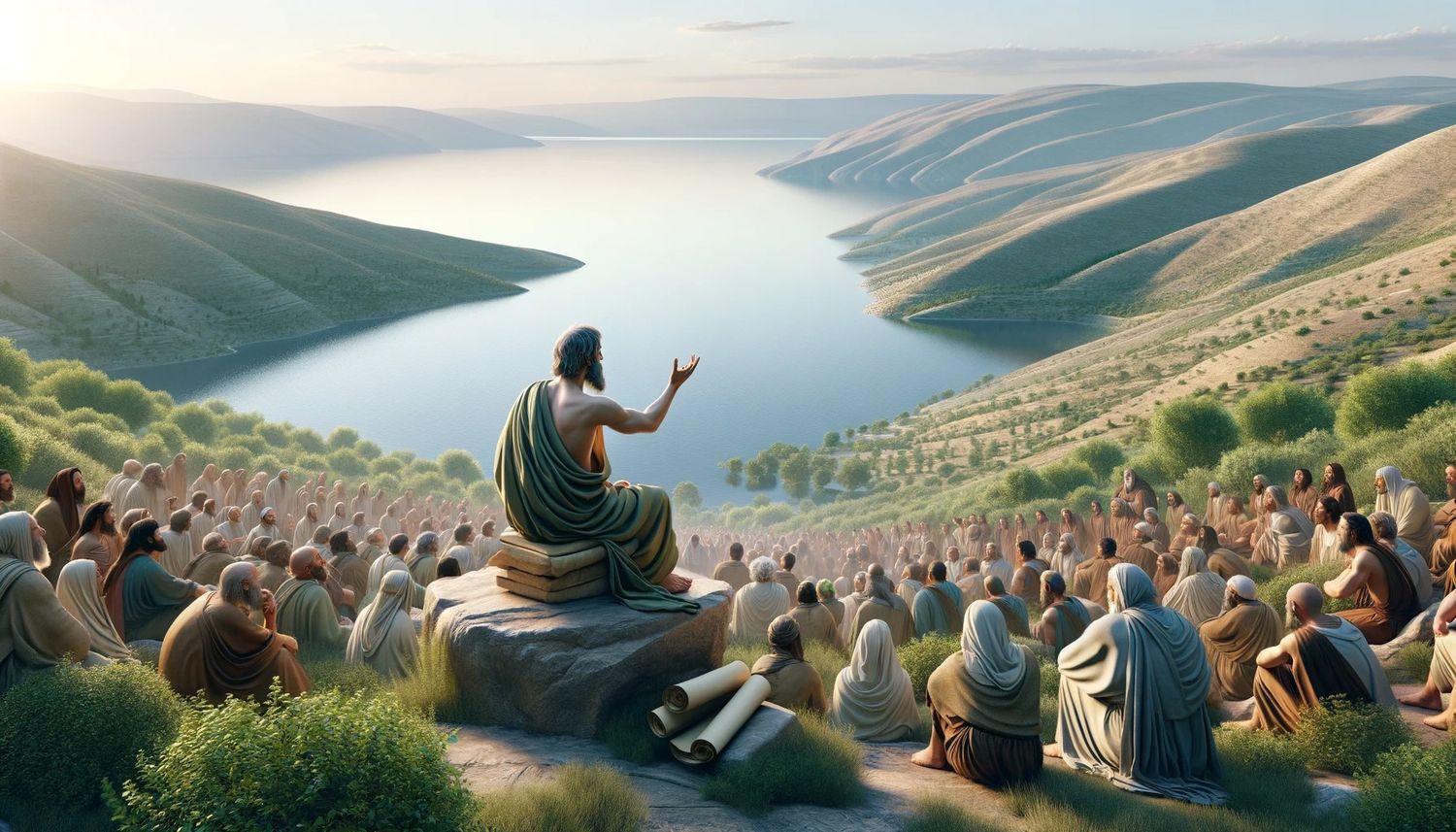Home>Christian Videos>Bible Stories>Where Do The Gospels Contradict Each Other


Bible Stories
Where Do The Gospels Contradict Each Other
Published: March 7, 2024
Ericka Andersen, an editor at Christian.net, expertly merges digital strategy with content creation, focusing on faith and societal issues. Her communication skills enhance the platform's engaging narratives, fostering meaningful dialogue on belief's impact on society.
Explore the intriguing differences and contradictions within the Gospels, shedding light on the complexities of these timeless Bible stories. Delve into the varying perspectives and interpretations of the Gospel narratives.
(Many of the links in this article redirect to a specific reviewed product. Your purchase of these products through affiliate links helps to generate commission for Christian.net, at no extra cost. Learn more)
Table of Contents
Introduction
Where do the Gospels contradict each other? This is a question that has puzzled scholars and believers for centuries. The four Gospels – Matthew, Mark, Luke, and John – are the first books of the New Testament and provide accounts of the life, teachings, death, and resurrection of Jesus Christ. While they share many similarities, there are also apparent discrepancies in the details of certain events and teachings. These apparent contradictions have led to debates and discussions about the reliability and accuracy of the Gospels. In this article, we will explore some of the key areas where the Gospels seem to differ and consider how these differences can be understood within the context of the broader message of the New Testament.
Read more: What Do The Four Gospels Represent?
The Nativity and Genealogy of Jesus
The nativity and genealogy of Jesus are significant aspects of the Gospels, as they establish the historical and divine lineage of Jesus. However, when comparing the nativity and genealogy accounts in Matthew and Luke, some apparent contradictions arise. In Matthew, the genealogy traces Jesus' lineage through his legal father, Joseph, back to King David and Abraham. On the other hand, Luke's genealogy differs in its details, tracing Jesus' lineage through Mary's line, also back to David and Abraham. Additionally, the nativity narratives in Matthew and Luke differ in the details of Jesus' birth, the events surrounding it, and the individuals involved. These differences have led to questions about the accuracy and historical reliability of the Gospels in portraying the birth and ancestry of Jesus.
- The genealogy of Jesus in Matthew and Luke
- The nativity narratives in Matthew and Luke
- The discrepancies in the details of Jesus' birth and ancestry
- The implications of these differences for the reliability of the Gospels
The Resurrection and Post-Resurrection Appearances
The accounts of the resurrection and post-resurrection appearances of Jesus in the Gospels have been a subject of intense scrutiny and debate. While all four Gospels affirm the central belief in Jesus' resurrection, there are variations in the details of the events surrounding it. For instance, the number and identity of the women who visited the tomb and the sequence of the appearances of Jesus to his disciples differ across the Gospels. In Matthew, an earthquake accompanies the angel's descent to roll back the stone from the tomb, while Mark and Luke do not mention this. Additionally, the Gospels present varying details about the individuals to whom Jesus appeared after his resurrection and the locations of these appearances.
- The accounts of the resurrection in the four Gospels
- The variations in the details of the post-resurrection appearances
- The number and identity of the women at the tomb
- The sequence and locations of Jesus' appearances to his disciples
- The implications of these differences for the understanding of the resurrection event
The variations in the accounts of the resurrection and post-resurrection appearances in the Gospels have prompted discussions about the nature of historical truth and the theological significance of these events. While some view these differences as discrepancies that challenge the reliability of the Gospel narratives, others interpret them as complementary perspectives that enrich the overall understanding of the resurrection and its impact on the early Christian community. Understanding the diverse theological and literary purposes of the Gospel writers can provide insights into the significance of these variations and their implications for the broader message of the Gospels.
The Last Supper and Crucifixion
The accounts of the Last Supper and the Crucifixion in the four Gospels provide essential details about the final moments of Jesus' earthly ministry. However, when comparing the narratives of these events, variations and apparent contradictions emerge. The timing of the Last Supper, the details of the Passover meal, and the sequence of events leading to the Crucifixion differ across the Gospels. For example, while Matthew, Mark, and Luke depict the Last Supper as a Passover meal, John presents it as occurring before the Passover. Additionally, the Gospels offer different perspectives on the words spoken by Jesus during the Last Supper and the events that transpired immediately afterward.
- The timing and nature of the Last Supper in the four Gospels
- The details of the Passover meal and its significance in the Last Supper narratives
- The sequence of events leading to the Crucifixion as portrayed in the Gospels
- The variations in the words spoken by Jesus during the Last Supper
- The implications of these differences for understanding the significance of the Last Supper and Crucifixion
The discrepancies in the accounts of the Last Supper and Crucifixion have led to scholarly discussions about the historical reliability of the Gospels and the theological implications of these events. Some scholars have proposed harmonizations to reconcile the differences, while others emphasize the distinct theological emphases of each Gospel writer. Understanding the diverse perspectives and theological intentions of the Gospel authors can shed light on the significance of these variations and their implications for the broader message of the Gospels.
The Teachings and Parables of Jesus
The teachings and parables of Jesus form a central aspect of the Gospel narratives, conveying profound spiritual truths through vivid and relatable stories. However, when examining the teachings and parables attributed to Jesus in the four Gospels, variations and differences in the details and contexts of these teachings become apparent. Each Gospel presents a unique selection of Jesus' teachings and parables, often with variations in wording and emphasis. For example, the Sermon on the Mount, a significant collection of Jesus' teachings found in the Gospel of Matthew, differs in its presentation and content from the parallel passages in the Gospels of Mark and Luke. Similarly, the parables of Jesus, such as the Parable of the Sower and the Parable of the Prodigal Son, are presented with distinct nuances and contextual settings in the different Gospel accounts.
- The Sermon on the Mount and its variations across the Gospels
- The distinct selection and presentation of Jesus' teachings in each Gospel
- The variations in the parables of Jesus and their contextual settings
- The implications of these differences for understanding the message of Jesus' teachings
- The theological significance of the diverse portrayals of Jesus' teachings and parables
The variations in the teachings and parables of Jesus across the Gospels have prompted discussions about the nature of oral tradition, the role of the Gospel writers as interpreters of Jesus' message, and the theological emphases of each Gospel. While some may perceive these differences as discrepancies that challenge the reliability of the Gospel narratives, others view them as complementary perspectives that enrich the multifaceted portrayal of Jesus' teachings and their relevance to diverse audiences. Understanding the diverse theological and literary purposes of the Gospel writers can provide insights into the significance of these variations and their implications for the broader message of the Gospels.
Read more: Where Did The Apostles Preach The Gospel
Conclusion
In conclusion, the apparent contradictions among the Gospels have been a subject of scholarly inquiry and theological reflection. While these differences may raise questions about the historical accuracy and reliability of the Gospel narratives, they also offer valuable insights into the diverse perspectives and theological emphases of the Gospel writers. Understanding the distinct literary, theological, and cultural contexts in which each Gospel was composed can provide a framework for interpreting the variations and reconciling the apparent contradictions. Moreover, recognizing the multifaceted nature of the Gospel accounts can enrich our understanding of the richness and complexity of the Christian faith. Ultimately, the differences among the Gospels invite us to engage in a deeper exploration of the message and significance of the life, teachings, death, and resurrection of Jesus Christ, as conveyed through the diverse voices of Matthew, Mark, Luke, and John.














